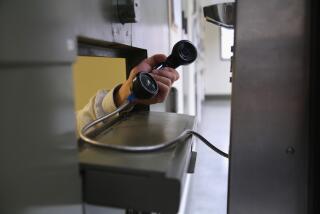At Guantanamo, a Cross-the-Fence Chat
- Share via
GUANTANAMO BAY NAVAL BASE, Cuba — When U.S. military contractors were preparing to erect wind turbines atop John Paul Jones Hill, the commander of the U.S. naval base worried that the Cuban sentries eyeing everything that goes on here would mistake the 185-foot-tall cylinders for missile silos.
So at the monthly Northeast Gate meeting in late 2004, Navy Capt. Leslie J. McCoy gave a heads up to Cuban Army Brig. Gen. Jose Solar Hernandez.
The only regular contact between U.S. and Cuban officials, the fence-line meetings on the third Friday of each month have become a vital forum for averting misunderstandings that could lead to disaster.
“Anything out of the ordinary, I try to keep them informed,” said the current base commander, Navy Capt. Mark Leary. The meetings, which occur on alternating sides of the fence, are “very pragmatic” and free of the political rhetoric that can cloud U.S.-Cuban relations at higher levels, Leary said.
“Both sides have tried to make it as local and geographically focused as possible,” he said. “It’s not a forum for national issues.”
Neither Havana officials nor their Washington counterparts will say much about their contacts, military or otherwise, which occur despite the absence of formal diplomatic relations.
But they don’t end at the fence line in Guantanamo. The 51 diplomats at the U.S. Interests Section in Havana occasionally confer with Cuban authorities as well as dissidents. And thousands of U.S. citizens nurture an ever-shrinking network of contacts through agricultural trade events and, for Cuban Americans, remittances to relatives and visits to the homeland.
“All in all, we have a fairly robust and fairly large number of data points where we can get to Cubans on a regular basis,” said a State Department official with knowledge of Cuban matters, who could not be identified because the Bush administration hadn’t authorized him to speak.
The U.S.-Cuban contacts come despite hardening relations. In January 2004, the State Department scrapped twice-yearly migration talks, accusing Cuba of not negotiating seriously. In June of that year, the administration imposed harsh restrictions on travel to Cuba, halting most religious and cultural exchanges and limiting family visits to once every three years. This year, the Florida Legislature quashed most academic contacts by prohibiting the use of public funds for visits by state university professors or students.
“I find it ridiculous that we cannot send experts to Cuba. How are we going to understand that society? How are we going to deal with what is happening there if we don’t know what is happening there?” said Sebastian Arcos, a former Cuban political prisoner who lives in Miami and oversees community outreach for Florida International University’s international studies department.
“We are shooting ourselves in the foot,” Arcos said. “You need to know your enemy. You need to keep your enemies closer than your friends.”
The only topic that Cubans and Americans seem to agree to discuss openly is the weather: Cuban authorities have allowed U.S. military planes flying reconnaissance for the National Hurricane Center to enter Cuban airspace during the last three storm seasons, and the two governments’ weather services have collaborated for at least 30 years by sharing forecasting data, hurricane center spokesman Chris Vaccaro said.
“It is not only desirable but necessary to save human lives,” the head of Cuba’s Meteorological Institute, Jose Rubiera, told journalists in Havana before the beginning of the current storm season, which ends Nov. 30.
Veteran Cuba watchers such as Julia Sweig of the Council on Foreign Relations contend that blocking avenues for interaction increase the risk of conflict, especially with the uncertainty over the island’s future now that President Fidel Castro is ill.
“It’s a very, very big problem because if you get to the point where Fidel Castro does die and people in Miami get involved, there could be all kinds of scenarios to drive the United States and Cuba into conflict,” said Sweig, Latin American studies director for the council and author of two historical works on Cuba. “The U.S. government wouldn’t know who to call.”
That official isolation gives added importance to the fence-line meetings at Guantanamo.
U.S. Marine Cpl. Conrado Perales, a Spanish-speaking supply clerk from Texas who acts as interpreter at the sessions, says he relishes being part of the bilateral forum.
Perales recalled that a Cuban offer to send doctors to help Hurricane Katrina victims was relayed through the fence line, as was a U.S. offer to help quell a nearby forest fire last year. Although both gestures were spurned, he said they demonstrated the importance of keeping a channel open.
Leary attends the meetings with Thomas Gerth, a senior advisor to the State Department’s Office of Cuban Affairs who flies in for the talks; an aide to Leary; an officer of the Marine detachment that provides security for the fence line; and two Spanish-speaking troops from among the base personnel.
The Cuban contingent likewise consists of six people, headed by naval Capt. Pedro Ramon Cisneros, since Solar’s retirement this year.
The two delegations spend about 40 minutes on what Leary describes as a heavily scripted agenda, then half an hour chatting over breakfast: fruit and pastries if the Cubans are the hosts, bacon and eggs if the Yanks cater.
Polite chit-chat inevitably turns to baseball, Leary said.
But even baseball can get political. This year, the Bush administration tried unsuccessfully to exclude Cuba from the inaugural World Baseball Classic series.
“They let us know how they felt about that one,” Leary said.
More to Read
Sign up for Essential California
The most important California stories and recommendations in your inbox every morning.
You may occasionally receive promotional content from the Los Angeles Times.











